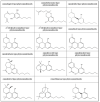Phytocannabinoids in the Pharmacotherapy of Psoriasis
- PMID: 36770858
- PMCID: PMC9920113
- DOI: 10.3390/molecules28031192
Phytocannabinoids in the Pharmacotherapy of Psoriasis
Abstract
Phytocannabinoids are naturally occurring compounds, the main source of which is Cannabis sativa L. Through direct action or interaction with G protein-coupled receptors, they affect ROS and pro-inflammatory cytokines levels and modify the effectiveness of transcription factor responsible for the biosynthesis of antioxidants which lead to oxidative stress and its consequences. Due to the modification of the redox balance and inflammation, phytocannabinoids are used in the treatment of various diseases, including autoimmune dermatoses, such as atopic dermatitis and psoriasis. Psoriasis is one of the most common dermatoses, and one of unknown etiology. A disturbed redox balance with a shift towards the oxidation leads to oxidative stress, resulting in oxidative modifications, mainly of lipids and proteins, and prolonged activation of immune cells and increased generation of pro-inflammatory cytokines, resulting in chronic inflammation. Given the biological activity of phytocannabinoids, they have become the focus of research as components of pharmacotherapy for psoriasis. Beneficial effects were shown by various representatives of phytocannabinoids, but the effect of cannabidiol (CBD) on skin cells (in vitro and ex vivo) and on blood cells from patients with psoriasis vulgaris and psoriatic arthritis has been most often evaluated in recent years.
Keywords: CBD; blood cells; inflammation; oxidative stress; phytocannabinoids; psoriasis; skin cells.
Conflict of interest statement
The authors declare no conflict of interest.
Figures


Similar articles
-
Cannabis sativa and Skin Health: Dissecting the Role of Phytocannabinoids.Planta Med. 2022 Jun;88(7):492-506. doi: 10.1055/a-1420-5780. Epub 2021 Apr 13. Planta Med. 2022. PMID: 33851375 Review.
-
Cannabidiol Effects on Phospholipid Metabolism in Keratinocytes from Patients with Psoriasis Vulgaris.Biomolecules. 2020 Feb 28;10(3):367. doi: 10.3390/biom10030367. Biomolecules. 2020. PMID: 32121131 Free PMC article.
-
Cannabidiol exerts multitarget immunomodulatory effects on PBMCs from individuals with psoriasis vulgaris.Front Immunol. 2024 Mar 27;15:1373435. doi: 10.3389/fimmu.2024.1373435. eCollection 2024. Front Immunol. 2024. PMID: 38601151 Free PMC article.
-
Cannabidiol Mediates In Vitro Attenuation of Proinflammatory Cytokine Responses in Psoriatic Disease.Cannabis Cannabinoid Res. 2024 Feb;9(1):134-146. doi: 10.1089/can.2023.0237. Epub 2024 Jan 5. Cannabis Cannabinoid Res. 2024. PMID: 38181167
-
Antioxidant activity, lipid peroxidation and skin diseases. What's new.J Eur Acad Dermatol Venereol. 2003 Nov;17(6):663-9. doi: 10.1046/j.1468-3083.2003.00751.x. J Eur Acad Dermatol Venereol. 2003. PMID: 14761133 Review.
Cited by
-
The Perspective of Cannabidiol in Psoriasis Therapy.Psoriasis (Auckl). 2024 Jun 19;14:51-61. doi: 10.2147/PTT.S469698. eCollection 2024. Psoriasis (Auckl). 2024. PMID: 38911997 Free PMC article. Review.
-
Patients' perspectives on marijuana use for inflammatory bowel disease: a multicenter survey.Ann Gastroenterol. 2023 Nov-Dec;36(6):624-629. doi: 10.20524/aog.2023.0829. Epub 2023 Sep 12. Ann Gastroenterol. 2023. PMID: 38023973 Free PMC article.
-
Therapeutic Potential of Minor Cannabinoids in Dermatological Diseases-A Synthetic Review.Molecules. 2023 Aug 20;28(16):6149. doi: 10.3390/molecules28166149. Molecules. 2023. PMID: 37630401 Free PMC article. Review.
-
Cannabidiol and Cannabigerol Modify the Composition and Physicochemical Properties of Keratinocyte Membranes Exposed to UVA.Int J Mol Sci. 2023 Aug 4;24(15):12424. doi: 10.3390/ijms241512424. Int J Mol Sci. 2023. PMID: 37569799 Free PMC article.
-
Cannabidiol and Minor Phytocannabinoids: A Preliminary Study to Assess Their Anti-Melanoma, Anti-Melanogenic, and Anti-Tyrosinase Properties.Pharmaceuticals (Basel). 2023 Apr 26;16(5):648. doi: 10.3390/ph16050648. Pharmaceuticals (Basel). 2023. PMID: 37242431 Free PMC article.
References
Publication types
MeSH terms
Substances
LinkOut - more resources
Full Text Sources
Medical

